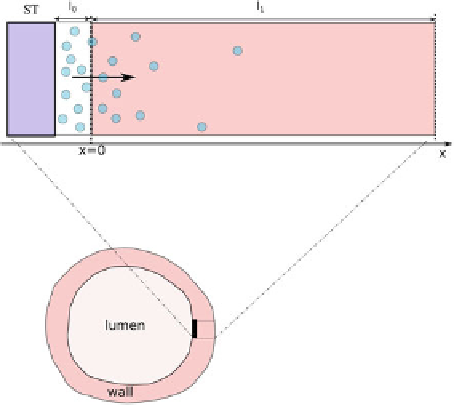Biomedical Engineering Reference
In-Depth Information
the influence of drug dissolution in the coating has been addressed [
16
,
17
] with a
model where the effect of different modeling assumptions on the predictions of the
transport of sirolimus and paclitaxel in stented arteries has been studied [
15
]. All
other mechanical effects (such as compression and expansion) due to the metallic or
polymeric degradation/erosion are neglected.
Our results demonstrate a strong coupling of the release kinetics in the polymer
and the drug dynamics in the wall. The results highlight the importance of tailoring
drug release to drug kinetics in the arterial wall to ensure optimal DES performance.
2 A Two-Layer Model for Drug Elution
We consider a stent that is coated with a thin layer (of thickness
l
0
) of a porous
polymer containing a drug and that is embedded into the arterial wall. As the bulk
of drug transport occurs along the direction normal to the polymeric surface (radial
direction) and by assuming axial symmetry, we can restrict our study to a simplified
one-dimensional model (Fig.
1
). In particular, we consider a radial line crossing the
metallic strut, the coating and the arterial wall and pointing outwards. Because the
wall thickness is very small compared to the radius of the artery, a Cartesian coordi-
nate system
x
is used along the radial line. For simplicity, we consider the situation
where the stent polymer is in direct contact with the medial layer of the arterial
wall (hereafter simply referred to as
wall
). This layer is modeled as a homogeneous
porous medium of thickness
l
1
. Without loss of generality, we assume
x
=
0isthe
coating-wall interface (Fig.
1
).
Fig. 1
Cross-section of the
stent mesh, the coating, and
the arterial wall: geometrical
configuration and reference
system (figure not to scale)
lumen


